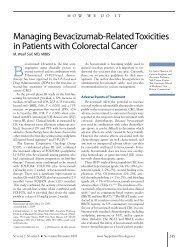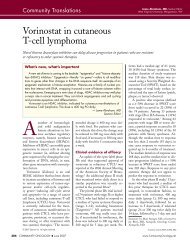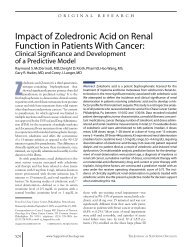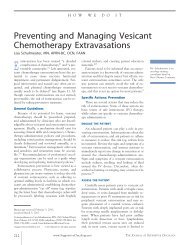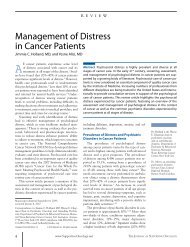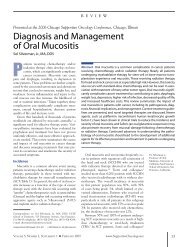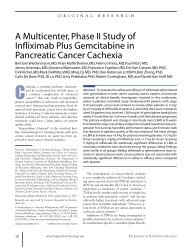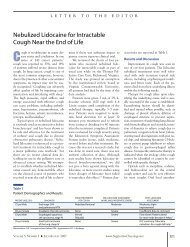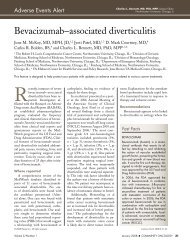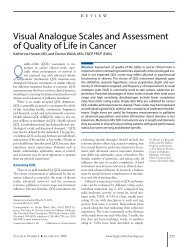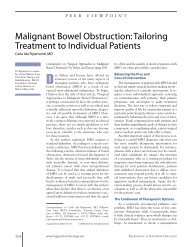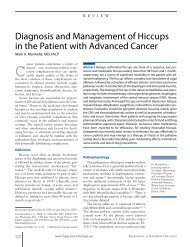Volume 9 Number 3 March 2012 - Oncology Practice Digital Network
Volume 9 Number 3 March 2012 - Oncology Practice Digital Network
Volume 9 Number 3 March 2012 - Oncology Practice Digital Network
You also want an ePaper? Increase the reach of your titles
YUMPU automatically turns print PDFs into web optimized ePapers that Google loves.
Review<br />
Therapeutic optimization of aromatase<br />
inhibitor–associated arthralgia: etiology,<br />
onset, resolution, and symptom<br />
management in early breast cancer<br />
Cheryl Jones, MD, 1 James Gilmore, PharmD, 1 Mansoor Saleh, MD, 1<br />
Bruce Feinberg, DO, 1 Michelle Kissner, RPh, PharmD, 2 and Stacey J. Simmons, MD 2<br />
1 Georgia Cancer Specialists, Macon, GA; 2 Pfizer Inc., New York, NY<br />
Third-generation aromatase inhibitors (AIs) used in the treatment of hormone-responsive breast cancer are associated with arthralgia,<br />
which is the most common reason for treatment discontinuation. This review characterizes the observed arthralgia and describes its<br />
variable definitions in key clinical trials; its typical onset and duration; symptom management strategies; and symptom resolution. The<br />
symptomatic manifestations of AI-associated arthralgia are highly variable, with typical onset occurring 2-6 months after treatment<br />
initiation. Aromatase inhibitor-associated arthralgia is most often bilateral and symmetrical, involving hands and wrists. Other common<br />
locations include knees, hips, lower back, shoulders, and feet. To improve standardization of care as well as patient quality of life, we<br />
propose a diagnostic algorithm for the management of patients who receive AIs and who develop arthralgia or worsening symptoms<br />
from preexisting joint pain. We conclude that although arthralgia is often associated with AI therapy, prompt diagnosis and<br />
management of musculoskeletal symptoms may ensure continued AI treatment and improve quality of life.<br />
The use of third-generation aromatase inhibitors<br />
(AIs) such as anastrozole, letrozole,<br />
and exemestane for the treatment of<br />
postmenopausal women with hormone-sensitive<br />
breast cancer has increased steadily since 2000,<br />
and AIs have been incorporated into many clinical<br />
practice guidelines as an effective therapeutic option.<br />
1,2 In the adjuvant setting, AIs reduce the risk<br />
of recurrence by 20%-29% relative to tamoxifen. 3,4<br />
Increased use of AIs has led to broader awareness<br />
of their side-effect profiles, leading clinicians to<br />
consider proactive management of some symptoms<br />
with the intent to improve adherence to<br />
therapy.<br />
Anastrozole and letrozole reversibly block the<br />
cytochrome P450 enzyme aromatase, while exemestane<br />
irreversibly blocks aromatase, but a re-<br />
Manuscript received May 19, 2011; accepted February 7, <strong>2012</strong>.<br />
Correspondence: Cheryl Jones, MD, 308 Coliseum Drive,<br />
Suite 120, Macon, GA 31217; e-mail: Cheryl.Jones@<br />
gacancer.com.<br />
Disclosures: Ms. Kissner and Dr. Simmons are employees and<br />
stockholders of Pfizer Inc.; they contributed to the study’s concept<br />
and design; Ms. Kissner was also involved in the collection,<br />
analysis, and interpretation of the data. Dr. Saleh has received<br />
clinical research funding from Pfizer Inc. Drs. Jones, Gilmore,<br />
and Feinberg report no potential conflicts of interest.<br />
Funding: Pfizer Inc. provided support for medical editorial<br />
assistance.<br />
view of the major adjuvant studies has shown that<br />
the three AIs have similar safety profiles and<br />
disease-free survival rates. 5 One of the commonly<br />
reported adverse events (AEs) is arthralgia, which<br />
occurs in 18%-36% of patients 5-7 and is particularly<br />
important for postmenopausal women who<br />
have an increased incidence of joint complaints.<br />
Indeed, the reported arthralgia incidence in the<br />
general population of postmenopausal women is<br />
as high as 74%. 8 In a recent survey of 416 breast<br />
cancer specialists, 92% graded AI-induced arthralgia<br />
as important or very important. 9<br />
Subsequent data analyses of AI adjuvant studies<br />
show that about 2%-20% of patients reporting arthralgia<br />
discontinue treatment. 7,10,11 In addition,<br />
retrospective analyses of survey data and medical<br />
records from either clinical practice or prescription<br />
refill databases have shown that adherence to AI<br />
regimens significantly decreased after 1 year of treatment<br />
(to 82%-88%) and continued to decrease<br />
through year 3 (to 62%-79%). 12-14 The reasons for<br />
treatment nonadherence were varied, but they included<br />
AEs, especially those events that decrease<br />
quality of life, such as arthralgia. 5,15 Reduced<br />
medication compliance may then lead to de-<br />
Commun Oncol <strong>2012</strong>;9:94-101 © <strong>2012</strong> Elsevier Inc. All rights reserved.<br />
doi:10.1016/j.cmonc.<strong>2012</strong>.02.005<br />
94 COMMUNITY ONCOLOGY <strong>March</strong> <strong>2012</strong> www.Community<strong>Oncology</strong>.net



